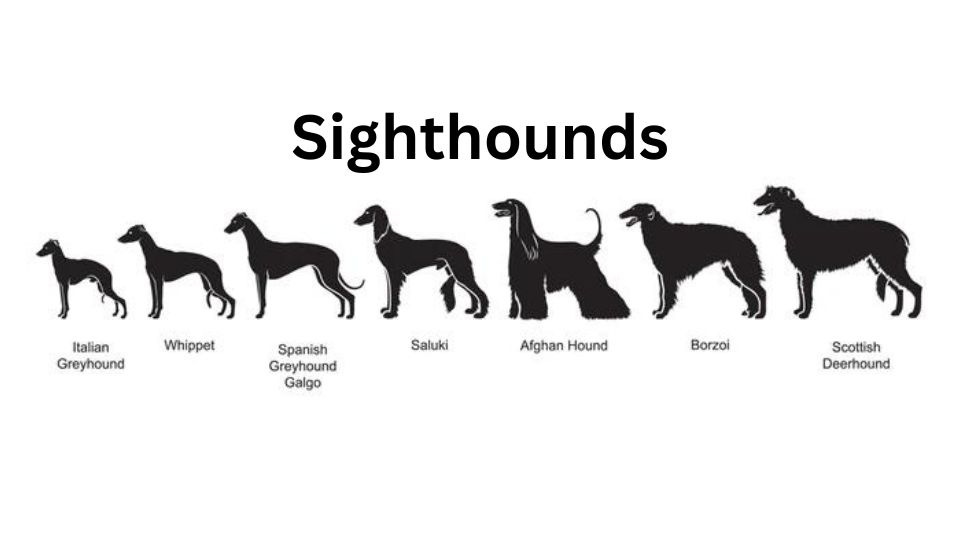A Greyhound is a sighthound, heralding from a large and influential family of breeds identified by their distinctive hunting style, which is largely dependent on their extraordinary sense of sight and substantial speed. The sighthound category includes several distinct breeds, each bearing unique characteristics while sharing commonalities linked to their vision and swift, agile hunting proficiency.
Understanding the Sighthound Category
Sighthounds, also referred to as ‘gazehounds’, are a type of hunting dog distinguished by their visual acuity and speed. Rather than relying primarily on scent like many hunting dog breeds, sighthounds pursue and capture game predominantly based on sight.
There are several distinctive breeds classified as sighthounds, and they include:
- Greyhounds
- Salukis
- Whippets
- Irish Wolfhounds
- Afghan Hounds
Sighthounds are typically lean, with deep chests and long, powerful legs designed for rapid acceleration and high-speed chase. Their keen eyesight allows them to spot and track fast-moving prey over vast distances. It is this unique combination of physical traits and hunting style that defines the sighthound classification.
Greyhounds as Predominant Sighthounds
Greyhounds, as one of the most iconic sighthound breeds, are renowned for their exceptional speed and agility. Originating over 2000 years ago in the Middle East and North Africa, they are one of the oldest dog breeds known to us.
Their distinctive physical attributes of a streamlined, lean body, deep chest for great lung capacity, and long, muscular limbs are aimed for endurance and speed, making them excellent sprinters. Greyhounds are one of the fastest dog breeds, capable of reaching speeds up to 45 miles per hour.
Their ability to scan the horizon and spot moving prey is another characteristic trait that firmly places them within the sighthound category. Unlike scent hounds, which track their quarry based on smell, Greyhounds rely mainly on their keen sight, which is sharper than most dog breeds.
Comparing Greyhounds with Other Sighthounds
While Greyhounds share many common characteristics with other sighthounds, there are also noticeable differences. For instance, Salukis, another ancient breed like the Greyhound, are known for their endurance over long distances rather than their sprinting ability.
Here is a simple comparison table to illustrate some differences among sighthound breeds:
| Breed | Speed | Endurance | Size |
|---|---|---|---|
| Greyhound | Very High | Moderate to High | Large |
| Saluki | High | Very High | Large |
| Whippet | High | Moderate | Medium |
| Irish Wolfhound | Moderate | High | Very Large |
| Afghan Hound | Moderate | Moderate | Large |
The variance in breed characteristics within the sighthound group underscores the diversity of these breeds, even as they share a common hunter type. Understanding the subtle differences and unique attributes of each breed can offer valuable insights into their behaviors, needs, and suitability as companions and pets.
No matter the breed, all sighthounds possess a common bond. They’re dogs who were bred to see, track, and pursue fast-moving prey, and they carry those instincts with them to this day – whether they’re racing on a professional track or simply chasing after a ball in the park.
Greyhound Hunting Style and Techniques
The Greyhound’s hunting style is a reflection of its sighthound classification. As highly visual hunters, they have developed specific techniques and skills that supplement their innate physical capabilities. These techniques include:
- Coursing: Greyhounds are adept at pursuing game over open terrain, relying heavily on their keen senses and incredible acceleration.
- High-speed chase: The Greyhound can reach top speeds quickly, giving it an advantage when chasing fast-moving prey such as hares or rabbits.
- Leaping ability: Greyhounds possess an exceptional leaping ability, enabling them to navigate obstacles and catch agile prey mid-air.
- Tracking: Although sighthounds primarily rely on their vision, Greyhounds are also capable of tracking prey by scent when necessary.
Roles and Activities Suited for Greyhounds
As descendants of efficient and skilled hunters, Greyhounds are a versatile and adaptable breed. Some activities and roles suited for them include:
- Dog racing: Greyhound racing has been a popular competitive sport for decades, showcasing their prowess in speed and agility.
- Lure coursing: This fast-paced activity tests a Greyhound’s hunting skills by encouraging them to chase a mechanically operated lure across a field.
- Agility competitions: While not specifically bred for agility, some Greyhounds may excel in this sport, demonstrating their balance, coordination, and speed.
- Companion pets: Greyhounds are known to be gentle, affectionate, and adaptable pets, suitable for various lifestyles and families.
| Activity | Speed | Agility | Endurance | Skill |
|---|---|---|---|---|
| Dog racing | Very High | High | Moderate | Moderate |
| Lure coursing | High | Moderate | High | High |
| Agility competitions | High | Moderate to High | Low | Moderate |
| Companion pets | N/A | N/A | N/A | High |
Sighthound-Specific Care and Considerations
Like other sighthounds, Greyhounds have specific care needs and considerations due to their unique genetic makeup and specialized hunting background.
- Proper nutrition: Greyhounds require a balanced diet prepared explicitly for their needs, taking into consideration their high metabolism, lean body, and limited fat stores.
- Regular exercise: As an energetic breed, Greyhounds benefit from daily exercise to maintain healthy muscle tone and promote well-being. However, they are also known to enjoy plenty of relaxation and rest periods.
- Gentle handling: Greyhounds are generally sensitive to rough treatment, and owners should be mindful of their delicate skin and lean bodies to prevent any injuries.
- Fenced areas: Given their strong prey drive, it is crucial to ensure Greyhounds are in secure, fenced locations when off-leash. This will help prevent them from chasing after small animals and getting lost or injured.
Addressing these specific needs is crucial for the long-term health and well-being of Greyhounds and other sighthound breeds. Awareness of their unique history, breed characteristics, and care requirements enables owners and enthusiasts to provide the best possible environment for these exceptional dogs to thrive in.




